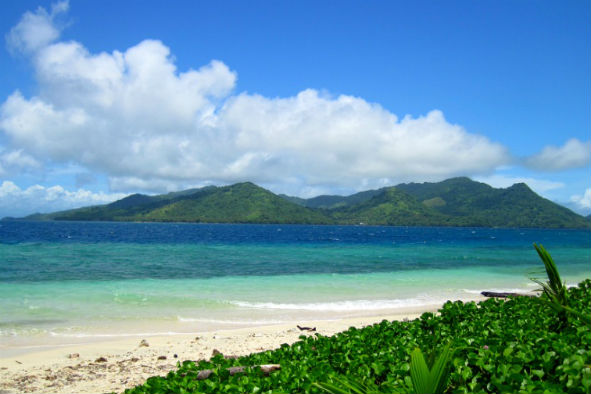Miles from the nearest continent with shores sculpted by the hands of the South Pacific, Fiji’s islands are a far-flung oasis of natural beauty and fascinating culture.

Photo: Oli Anderson via Flickr
The palms sigh into the wind as a dark, inky mist spills across the sky. The swallows have flown, the butterflies have vanished and Fiji quietly awaits the arrival of a thunderstorm to match The Tempest. The clouds, singed by the heat, tumble and grow, fairy liquid in a washing machine.
Announcing itself to the heavens, the storm omits a growl that echoes across the flat sea, before the clouds release a shower so forceful it might flatten any creature that dare confront it. Rain pummels the undergrowth, falling like cut emeralds through the leaves.
And then, as suddenly as it began, the storm rolls out, leaving in its wake a sunlit land so exquisite, so very surreal, that it might be nothing but a mirage.
Amethyst hummingbirds return to siphon nectar from flowers. The waves creep up the shore, sending tiny crabs scattering amongst fallen coconuts. Even those lanky, spindly palms stretch their leaves back into the rays, shuddering in the warmth. Nature’s behaviour on these faraway islands is unpredictable, sudden and intense. Everything feels wild and unkempt; a haircut long overdue.
Over a thousand years ago, the first South Pacific Islanders used the positioning of the stars, the strength of the breeze and the direction of ocean currents to navigate their canoes from one deserted island to the next. On a world map, Fiji is a smatter of dots, a finger’s width from New Zealand, just shy of New Caledonia. To get here takes plane after plane, a stretch of midnight airports, bleary eyes and watery coffee. But once here, it feels like being let in on a secret, hidden in plain sight.
Of over 300 islands, the two largest are Viti Levu and Vanua Levu, which host the majority of Fiji’s population in modern cities and rural towns. Across the Pacific channels, smaller and more remote islands are still home to communities that cling to their traditions. One afternoon, we clamber out of a canoe and tread through a dense mangrove swamp to a clearing with a cluster of straw-roofed bures. A couple of smiling children clasp our hands and lead us into the central hut. Once within, we sit cross-legged on carpets of pandanus leaves and adjust to the smouldering darkness, handing over our gifts of Kava.
Kava is used as a ceremonial means of bringing two groups of people together; it is customary to bring it as a gift when visiting a Fijian village. The dried roots are crushed to a powder and muddled with water, served in a deep wooden tanoa. The first sip is always offered to the eldest in the group, and the ceremony concludes with traditional dancing and laughter.
We emerge from the darkness and into daylight, shaded by lofty vesi trees and casuarina pines. The men chant, stamping bare feet into the floor, while the women sway their coloured sulus and giggle into their hands. As with many of Fiji’s riutals, it’s a laid-back affair punctuated with singing and story-telling..
Later, we walk an endless slither of beach at high tide. Frosted waves clutch at my ankles and the sand gives way, soft as flour between my toes. We submerge beneath the aquamarine surface to watch pygmy seahorses shiver in the current, tails twizzled about blades of seagrass. We float over the reef, searching for miniscule shells molded into intricate castles, mother of pearl, a fort of coral.
Fiji is a sanctuary for marine life, earning its name as ‘soft coral capital of the world’ with one of the most intricate underwater ecosystems. Of all the dives in the world, Fiji’s shark dive is said to be one of the most astounding, taking bold divers to watch natives hand-feed mammoth tiger and bull sharks in the murky depths. Numerous protected sites span across over 4,000 square miles of reef, home to endangered species of turtle, majestic manta rays and whales.
By the time we crawl onto the quiet beach, crinkled fingertips and hair thick with salt, the sun has begun to set. A couple of button-eyed geckos skitter past fallen frangipani flowers into the bush. Fruit bats swoop and swirl before a pastel landscape of gossamer clouds and a toothpaste white moon. In the very distance, where waves break over the reef, dolphins leap and twist in the spray.
All too soon, I find myself back at the airport, desperately hunting through a giftshop, sifting through garish souvenirs; sunglobes, grass skirts, chunky conch shells. I want to bring something of this land home, but it feels wrong to take something so tangible. I chance upon a room mist by local manufacturer Pure Fiji, a traditional blend of wildcrafted island ingredients: virgin coconut oil, sugarcane, passionflower. It smells like Fiji after the rain. That’s enough to remind me, on a sombre day in the city, that somewhere in the world there is such a place.